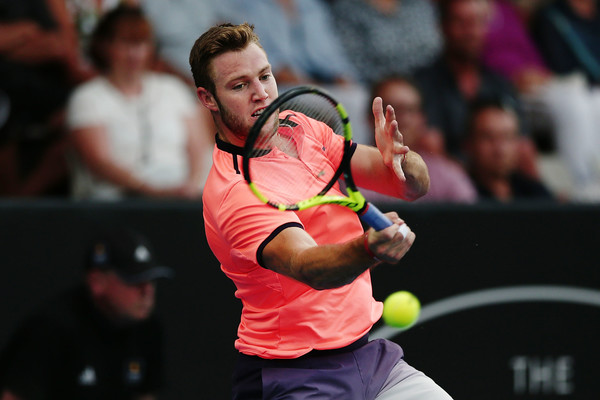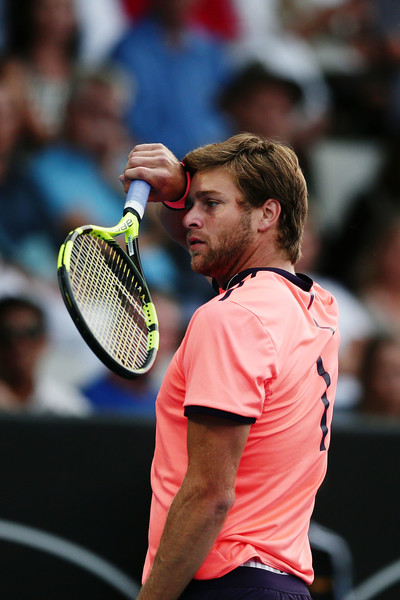The second round of the ASB Classic featured several entertaining matchups this year, but only one that pitted countryman against countryman. Third-seeded Jack Sock, playing after receiving a bye, was set to play the winner of 89th-ranked Ryan Harrison and Spain’s Guillermo Garcia-Lopez. Harrison crushed the Spaniard 6-1, 6-2 and also had to win three qualifying matches before the tournament. His confidence against the higher-ranked American’s projected a good match.
An Indirect Rivalry
This was the two young Americans’ only second meeting on the tour, despite the two both being 24 years of age. Their first meeting was five years ago on the hard courts of Memphis. So what has kept the two apart all this time? In short, the answer is mistimed rises up the rankings. Harrison hit his best stride far earlier than Sock, rising to rank 43 in 2012 (the same year he would beat Sock in their first meeting). Sock didn’t even break top 100 until early 2013, and that was a short-lived steadiness. In fact, the two would both dance just outside the top 100 throughout 2013, due to a drop in Harrison’s level. It was then that Sock would begin a slow climb, and Harrison would hit a deep slump.
Fast-forward to now, and Harrison’s just starting to get out. For the past couple of years, he has been firmly stuck in the 100-200 range, nearly dropping out at times. Now, after reaching the third round of the 2016 US Open, he’s back in at rank 89. The first time this high since his decline in 2013. Sock, on the other hand, is peaking at rank 24, approaching what is expected to be another successful season. The circumstances and stakes are clearly quite different than they were five years ago.

Sock Edges In Tiebreaker
The match kicked off with players trying to impose similar game plans. They both sport spin-heavy forehands and big serves, and prefer to keep the ball away from their backhands. Sock, visibly relaxed, came out sharp on the return and immediately broke serve, 1-0. The lead would be short-lived, as he gave Harrison the opportunity to break back in his next game. One chance was all he needed; with two impressive passing shots supported by a double fault, Harrison broke back for 2-2.
The next few games proceeded smoothly, each player easily holding serve up until 6-5. Sock was, for the most part, dictating the game’s rhythm, either overpowering in the rallies or quickly giving them up with an unforced error. Harrison hung with the Kansas-native by hitting several aces (even three in one game) and playing a solid defensive game. Pressure crept into Sock’s service game at 5-6, and an unforced error allowed Harrison a set point at 30-40. He fought it off, but a missed overhead gave Harrison another chance. Sock won a tense 15-shot rally to fend it off. Sock’s lack of challenges and Harrison’s extremely defensive baselining were frustrating the Nebraska-native.
Nevertheless, Sock held for 6-6. The tiebreak would play out exactly as the set had up until its start. After going down 0-3, Harrison’s big serve and an unforced error from his younger compatriot allowed him to come back to 5-4. It wouldn’t be enough to counter the clearly more powerful game, though. Sock took the breaker 7-5 as Harrison nearly slid into a linesperson chasing a forehand.
Harrison Forces A Decider
Not hiding his frustration, Harrison started the next set eager to correct his defensiveness. Playing more aggressively and fighting to stay closer to the baseline, he earned himself another break point at 1-1, 30-40. This time, Sock didn’t resist. A loose forehand error gave Harrison the early break. The patterns of the last set began to resume with Harrison’s ace count rising alongside Sock’s double fault count. But Sock turned up the consistency to win a few longer rallies and earn the break back for 3-3.
Harrison was back to playing yards behind the baseline. Similarly to the first set, it would yield chances to break Sock’s serve. Serving at 4-4, the younger American hit his overheads a bit too casually- one giving Harrison an impressive pass, another slapping the middle of the net. With another loose forehand error from Sock, Harrison broke serve for the second time in the set. This time he would hold without complication, Harrison 6-4. If anything in the match seemed boundless, it was Harrison’s will to chase down forehands.

Sock Cruises In Deciding Set
After a bathroom break for both players, the pair came out focused. But Sock’s focus had been seemingly lost for most of the match, whereas Harrison was already giving his all to keep the extra ball in play. He played his forehand more patiently and zeroed in on his friend’s serve. A quick hold and break to love were the results, 2-0. The frustration came out in Harrison’s next service game when he flicked his racket into the sky after netting a backhand, and a second break soon followed. As quick as his own sprints had been, the qualifier was down 0-5.
Harrison’s serve allowed him one more game, but Sock served out the set, 6-1. The lower-ranked American received a well-earned standing ovation from the crowd on his way out, and will hopefully take solace in the fact that he managed his serve brilliantly throughout the match. He served 17 aces and made 77 percent of first serves into play. If not for a few missed backhands at pivotal moments in the first two sets, the match likely would have played out differently.
Sock, on the other hand, needs to recover quickly for a night match against France’s Jeremy Chardy. The Frenchman didn’t play the second round due to his opponent retiring, so the third seed will need to come physically refreshed.










































